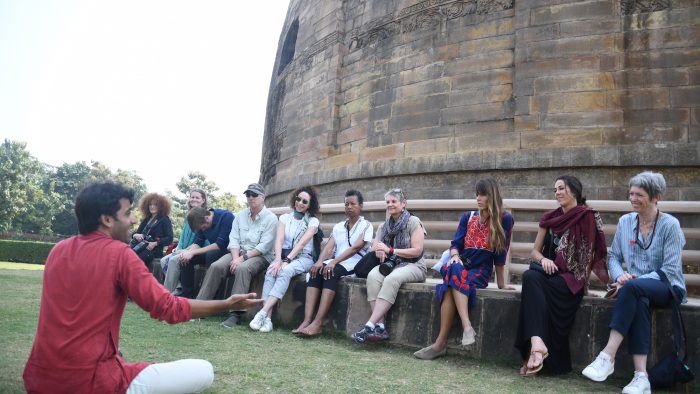“I felt the fact that there was no organized way of experiencing places was an opportunity to tap into the huge potential of Indian heritage,” says Heritage walks ‘Roobaroo’ Co-Founder Aayush Rathi
There are so many
little historical treasures that one misses out when one travels around India.
Many music lovers who sing the compositions of Muthuswamy Dikshitar, one of the
Trinity of Carnatic music, are not aware of a small Veda patashala situated
just before the descent to the Ganga River in Hanuman Ghat, near the Kanchi
Mutt in Varanasi. This Veda Patashala houses a Linga, consecrated on top of the
Jeeva Samadhi of Chidambara Naada Yogi, which was worshipped by Dikshitar for
eight years.
Dikshitar was trained
in various aspects of Mantra, Tantra and Yantra, the Vedas, Puranas, Agamas,
Yoga, the Advaitic philosophy of Shankara, the true spirit of inner
consciousness and the truth about the existence of life by Chidamabara Yogi, at
this very place. Dikshitar is supposed to have gone for a dip in the Ganga one
day and come up with a Veena with the word Ram inscribed on it in Sanskrit. This
would surely be a not-to-be-missed place for music lovers worldwide, if only
they knew about it.
In this context it is heartening to hear about Roobaroo, a young team which is showcasing India to the world through her different stories. Roobaroo which in Urdu word means soul to soul, was Co-Founded by Ayush Rathi, a graduate of India’s premier engineering and management schools – IIT Bombay and IIM Ahmedabad.

Aayush says the
use of Urdu for their company’s name, “represents the merging of two languages
and thought streams - an amalgamation, which is a hallmark of inclusive Indian
thought.” Their logo has the palindrome written in three languages - Hindi,
Urdu, and English.
Roobaroo curates
walks and experiences in Varanasi, Delhi, Amritsar, Lucknow, and Agra. Aayush
says they started the Walks at Varanasi “for the sheer depth of its heritage -
be it historical, cultural, philosophical, music, arts, architecture,
literature, and food. For over 3,000 years, this city has been the centre of
learning in India and the hotbed of human expression in various fields. The
continuity of Indian culture can be seen in its full glory in Varanasi and we've
seen travellers get a real sense of India here.”
Experiencing the
authentic flavour of Varanasi cuisine, includes a local cuisine lunch in the
18th-century haveli of the legendary writer - Bhartendu Harishchandra. “Along
with relishing its preparation in the haveli's open courtyard, the experience
is peppered with some fascinating discussions on poetry, society and book
reading. And leading the experience is the daughter- in-law of the writer's
family - who is herself a Storyteller for kids,” says Aayush.

“Along with relishing its preparation in the haveli's open courtyard, the experience is peppered with some fascinating discussions on poetry, society and book reading. And leading the experience is the daughter- in-law of the writer's family - who is herself a Storyteller for kids,” says Aayush.
It would be lovely to sit in the 16th century house of Tulsidas, overlooking the Ganga on the ghats of Varanasi, and wonder why he chose to write the Ramacharitamanas when we already had Valmiki’s Ramayana and be glad he did; or witness the fascinating sport of Kabootarbaazi (Pigeon flying) on the roof of a local house in Delhi’s Chandni Chowk; or cook Awadhi cuisine within the ancestral home of a Lucknowi family with Roobaroo.
The idea of
curated walks came to Aayush during this second year at IIM Ahmedabad during his
exchange semester in HEC Paris, when he got an opportunity to travel around
Europe. “When I get back to India, I started traveling around here and was
flabbergasted with the tremendous depth of our own culture. I felt the fact
that there was no organized way of experiencing these places was an opportunity
to tap into the huge potential of Indian heritage.”
Roobaroo has designed
Essential City Walks (3 hours long) in each of the cities to allow people the
calm of taking in the flavours at their own pace. “There are numerous other
walks to deep diver into the different themes, and food experiences as well as
cultural activities with local experts. We select from these other experiences based
on the person's interests,” says Aayush.
Some travellers have come back as many as five times across four different cities and soaked in upto 18 different experiences. To allow people to experience the melting pot that is Delhi, Roobaroo shares stories of the “amalgamation of the Hindu and Islamic civilizations facilitated by the pluralistic ideals of the Sufi saints - best experienced in heritage walks in Mehrauli and Chandni Chowk. The artistic marvels of Amir Khusro, Ghalib - through walks and performances in and around their homes, tombs, and places of work. The fascinating Indian food - inspired by myriad influences of the natives, invaders, merchants, settlers - best experienced through Food Walk in Chandni Chowk and Spice trail - from market to Kitchen.

“The story of the
unstructured, yet highly efficient Chandni Chowk. The third golden age of
Indian history under the glorious Mughals - best experienced in Shahjahanabad. Shaping
up of the Satyagraha movement by Mahatma Gandhi - best experienced at Birla
House and Gandhi Smriti. The rise and fall of colonialism - best experienced in
Lutyens Delhi. The story of India's first rising against the British -
experienced through the occupation and recapture of the Red Fort. The
neo-Indian arts scene through music, dance, poetry performances led by several
upcoming artists. The creative Indian legend scene - through the stories of
Djinns at Kotla Feroz Shah... the list can go on,” says Aayush.





